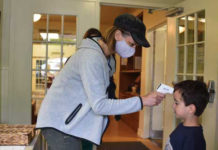
Wistful thoughts of warm summer sunshine and long days of outdoor fun often crowd our minds during the darker days of winter. But that feeling of longing isn’t unusual, or necessarily concerning. What is concerning, though, is when those feelings are constant and accompanied by symptoms like fatigue, weight gain, irritability, and sadness.
Seasonal affective disorder (SAD) is a type of depression that occurs during a certain time of year— most commonly during the long, dark winter months. About 2 to 3 percent of Canadians are thought to suffer from SAD. Although its origin is not absolutely clear, SAD is most commonly linked to a lack of sunlight.
Did you know?
SAD can also make the summer months the most hated season. For a small but significant minority of people, the condition, referred to as reverse or summer SAD, can cause symptoms like loss of appetite, sleep problems, weight loss, and anxiety.
01
Causes
While the cause of SAD isn’t currently known, research indicates that two neurotransmitters, serotonin and melatonin, may play a role in the disorder’s onset.
Serotonin, the “feel good” hormone, helps to regulate our moods. Low levels of light—as we experience during dreary seasons with short days and long nights—are associated with lower levels of serotonin in our bodies. As serotonin levels lower, so does our mood.
And just as low light levels are linked to decreased serotonin levels, they also cause an increase in melatonin, the hormone that saps our energy and helps us fall asleep at night. SAD sufferers may produce more melatonin at night and into the early morning, leaving them feeling lethargic through the day.
Those living in northern countries are at an increased risk of developing SAD. Women are more commonly affected than men.
Negative life experiences, such as losing a family member, losing your job, or having marital problems, along with having weak social systems, are also associated with an increased risk of SAD, as is having a close family member with the disorder.
02
Symptoms
SAD may be difficult to differentiate from other forms of depression because of the number of symptoms these various forms share. But the common denominator is the timing of symptoms: on a cycle, appearing and then disappearing during specific seasons. For wintertime SAD, the symptoms can include
- sadness
- irritability
- fatigue, lethargy
- social withdrawal
- loss of interest
- difficulty concentrating
- overeating, weight gain
Conversely, summer SAD normally causes difficulty sleeping and decreased appetite, leading to weight loss.
03
Treatment
Fortunately, there’s no need to muddle through the offending seasons, as treatment options do exist.
Conventional antidepressants such as selective serotonin reuptake inhibitors (SSRIs) can be effective for some people, but their numerous side effects mean they’re often used only as a last choice.
Light therapy
Shown to be just as effective as antidepressants for managing SAD’s symptoms with only minimal, if any side effects, light therapy can be taken in two forms: bright light therapy and dawn simulation.
Bright light therapy
As its name implies, this therapy involves exposing a patient to extremely bright lights, normally measuring 10,000 lux, for 30 or more minutes per day (a sunny day is about 50,000 lux).
04
Dawn simulation
Using longer exposure times of up to 90 minutes and gradually brightening lights to imitate a natural sunrise, light exposure with dawn simulation takes place while the patient is sleeping.
While researchers aren’t entirely sure why light therapy works, they believe that it resets our internal clocks. Bright light exposure has also been shown in some studies to increase our levels of serotonin while decreasing our levels of melatonin.
05
Negative air ions
Negative ions—atoms that have gained an extra electron—have long been recognized for having a positive effect on our moods. Naturally, they’re created by sunlight, and by moving air and water. However, they can also be created in devices known as negative ion generators.
Not all ion therapies are equal, though. One study has found that, while nearly half of SAD sufferers subjected to high-density ions showed significant signs of improvement, only about 23 percent of those exposed to low-density ions had similar relief.
06
Diet and exercise
Eating a healthy diet is important in managing SAD symptoms. Balanced meals rich in protein, complex carbohydrates, and healthy fats may help to keep unpredictable blood sugar levels—and the unpredictable moods that may accompany them— at bay.
Exercise, meanwhile, can help to relieve the stress that may build up as a result of SAD while reducing feelings of fatigue. Furthermore, studies have consistently shown that exercise may significantly improve the moods of those suffering from various forms of depression, including SAD.
07
Supplements: St. John\’s Wort
A thoroughly researched natural antidepressant, St. John’s wort may help ease the symptoms of SAD. It works by affecting the brain’s uptake of serotonin, as well as two other mood-controlling chemicals: dopamine and norepinephrine.
This herb can interact with many medications, so ask your health care practitioner to see if it’s right for you.
08
Supplements: Rhodiola rosea and Omega-3s
Rhodiola, often used to help those suffering from stress, has also been shown to be an effective treatment for mild to moderate depression.
Found in foods such as fish, flax, and nuts, omega-3s may affect the way in which serotonin works within the body. Animal research has shown that increasing the amount of omega-3s in the diet may help to correct imbalances caused by omega-3 deficiency.
09
Supplements: Vitamins
Vitamin D
The active hormone in vitamin D, calcitriol, affects several mood-controlling factors in the body, and some evidence shows a possible link between low levels of this and increased depressive symptoms. While some evidence hints that increased levels of vitamin D may help to manage these symptoms, more research is needed to come to a definite conclusion.
B vitamins
Some B vitamins—B9 (folic acid), B6, and B12—may also play a role in regulating our moods. Research is still evolving on the role of B-vitamin supplementation to help manage SAD and other forms of depression.
10
See the light!
Lifestyle changes—including getting as much natural sunlight as possible—are important components of managing SAD symptoms. During cold, blustery winter days, how can we get enough sunlight?
Explore outdoor activity options
Find an outdoor activity that you love. Whether it’s walking, skiing, or shovelling snow off the driveway, both the exercise and the increased light may help to manage symptoms. Check out some other interesting wintertime activity options on page 37.
Just get outside!
Get outside—even on a cloudy day. The amount of light we’re exposed to is higher when we’re outside, even on days when the sky’s grey instead of bright blue. If you don’t have opportunities to get outside, try spending as much time as you can by windows.
Every little bit helps
Remember that seeking the light—even in small doses—can help. For example, if you’re meeting business colleagues or friends at a coffee shop, pick one that has windows. Or, at work, eat your lunch in an area of the office that has light exposure.






























